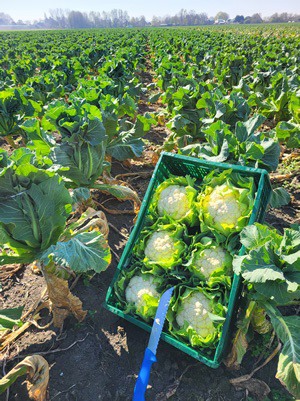 © P.N. Slagter
© P.N. Slagter
The harvest of winter cauliflower has started quietly at P.N. Slagter in Andijk. "We began two weeks later than last year. We're also dealing with drought this year. We're irrigating heavily now, but rain is always better for growth," observes Ruud Slagter. The later start also means that the cauliflower must be sold in a shorter timeframe. "It's just as well that all the winter cauliflower will be off the land by May," he says.
According to the cauliflower grower, the harvest of the first varieties is always a bit more challenging, but the outlook for the coming weeks is good. "There's slightly more winter cauliflower in the Netherlands this year, particularly due to an increase in a later variety. But it remains a difficult and risky crop. You really have to stay on top of harvest planning every day, as it's still much more unpredictable than summer cabbage."
"For supermarkets, volumes are still too low for now. In two to three weeks, larger quantities will be harvested," says Ruud. Therefore, according to the grower, demand has yet to pick up. "And the price largely depends on what's being paid in France and Spain. In Spain, quite a few fields have been flooded, but for now that hasn't led to high prices."
Winter romanesco
While winter cauliflower is a niche product, this is even more the case for winter romanesco. "We're not growing this crop ourselves this year but are sourcing it from a grower who supplies us," says Ruud. "The chances of harvesting winter romanesco are even slimmer than winter cauliflower, and the slightest frost causes the product to freeze. We've had winter romanesco for a few years now, but we've only had one year where we could harvest it properly."
Ruud—one of the five Slagter brothers—looks forward to the year with confidence. "Last year, we had to work very hard to get all the cabbage planted, but that's not an issue this year, and we're able to plant what we want." P.N. Slagter grows cauliflower on around 200 hectares and also markets cauliflower for five other farms, adding up to a total of about 230 hectares. Overall, the cauliflower acreage is seeing slight growth this year. "A large grower nearby has quit, while elsewhere there's some expansion, but it's not hundreds of hectares at a time," he says.
"The challenges in cultivation are significant. As outdoor growers, we'll have a problem if the pesticide Movento is soon phased out because, as far as I know, no good alternative has been found yet. Additionally, nitrogen limitations are quite a concern in this area. The entire region, within 50 kilometres north of Amsterdam, is subject to nitrogen restrictions due to pollution detected near Amsterdam. That means the whole area is limited to 20% less nitrogen. We're doing our best with precision fertilisation, among other things, but in the long run, it becomes unsustainable—because cauliflower needs nitrogen to grow."
 For more information:
For more information:
Ruud Slagter
Fa. P.N. Slagter
Kadijkweg 43
1619 PJ Andijk
Tel: +31 (0)6 37351433
ruud@pnslagter.nl
www.pnslagter.nl
